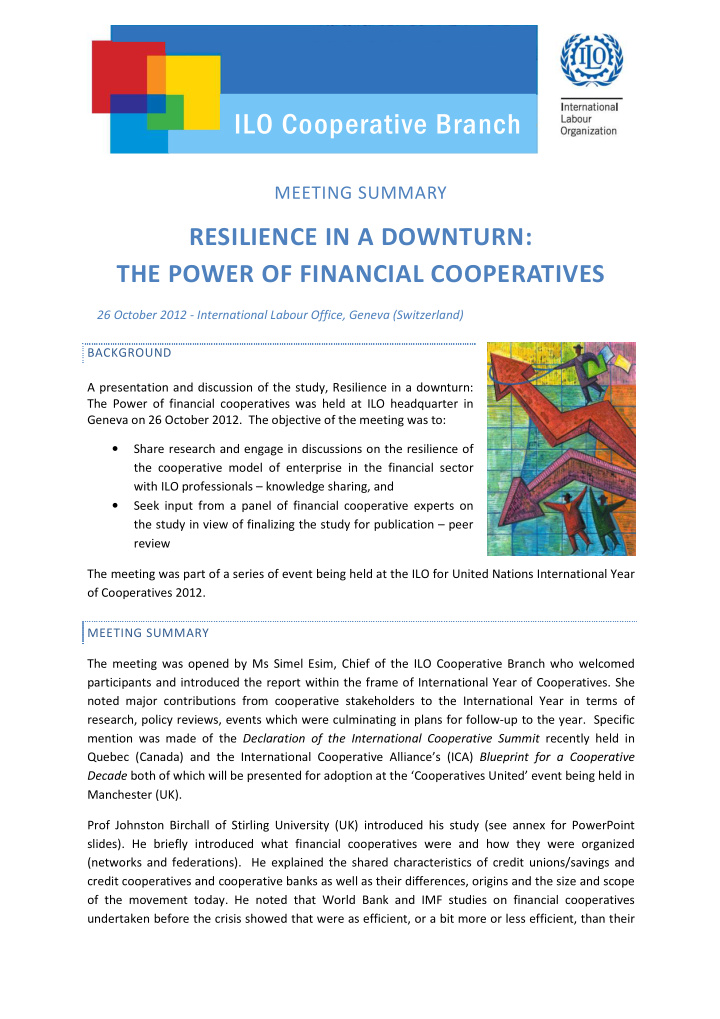



ILO Cooperative Branch MEETING SUMMARY RESILIENCE IN A DOWNTURN: THE POWER OF FINANCIAL COOPERATIVES 26 October 2012 - International Labour Office, Geneva (Switzerland) BACKGROUND A presentation and discussion of the study, Resilience in a downturn: The Power of financial cooperatives was held at ILO headquarter in Geneva on 26 October 2012. The objective of the meeting was to: • Share research and engage in discussions on the resilience of the cooperative model of enterprise in the financial sector with ILO professionals – knowledge sharing, and • Seek input from a panel of financial cooperative experts on the study in view of finalizing the study for publication – peer review The meeting was part of a series of event being held at the ILO for United Nations International Year of Cooperatives 2012. MEETING SUMMARY The meeting was opened by Ms Simel Esim, Chief of the ILO Cooperative Branch who welcomed participants and introduced the report within the frame of International Year of Cooperatives. She noted major contributions from cooperative stakeholders to the International Year in terms of research, policy reviews, events which were culminating in plans for follow-up to the year. Specific mention was made of the Declaration of the International Cooperative Summit recently held in Quebec (Canada) and the International Cooperative Alliance’s (ICA) Blueprint for a Cooperative Decade both of which will be presented for adoption at the ‘Cooperatives United’ event being held in Manchester (UK). Prof Johnston Birchall of Stirling University (UK) introduced his study (see annex for PowerPoint slides). He briefly introduced what financial cooperatives were and how they were organized (networks and federations). He explained the shared characteristics of credit unions/savings and credit cooperatives and cooperative banks as well as their differences, origins and the size and scope of the movement today. He noted that World Bank and IMF studies on financial cooperatives undertaken before the crisis showed that were as efficient, or a bit more or less efficient, than their
competitors; they were at least as profitable, and in several countries more profitable and that they were more stable than the investor-owned banks. Turning to data on the performance of financial cooperatives during the financial crisis, Prof Birchall noted that the data confirmed that financial cooperatives suffered far less than other banks. Only a few central banks had to accept government assistance, and, rather than being allowed to fail, weaker cooperative societies have merged with stronger ones. Most of the losses incurred were made up within a year or two as members recapitalized their cooperatives, and only in few countries did primary societies have had to ‘bail out’ their centrals. Today, nearly all the indicators show that financial cooperatives have bounced back and are growing again. This resilience has had an indirect impact on employment as financial cooperatives were often the only financial institutions that continued lending to SMEs during the crisis. Prof Birchall attributed the reason for resilience to the cooperative structure (member ownership and benefit) and the comparative advantages of financial cooperatives. He noted too that what had been considered disadvantages of the financial cooperatives – risk aversion, lack of stock option/remuneration incentives which has been said does not attract the best talent, and lack of access to capital - were recognized as advantages of the model during the crisis. He turned to policy issues, Prof Birchall noted that an enabling environment for cooperatives was key the growth of financial cooperatives. He stressed that government’s political interference and inappropriate regulation (overregulation in developed countries and too little in developing countries) has hindered financial cooperative development. He further underlined that cooperative are not and should not be conduits for government policies and interventions. He presented a series of country scenarios offering recommendations on how to promote the development, strengthening and growth of financial cooperatives. He linked financial cooperative development to other forms of development particularly supply chain development, small business development and the development of microfinance. He concluded that the financial cooperatives contribute not only to financial deepening but also the democratization of credit. Mr Jean-Louis Bancel, President of Crédit Coopératif of France, chair of the International Cooperative Banking Association (ICBA) and former chair of the International Cooperative and Mutual Insurance Federation (ICMIF) noted that the International Year of Cooperatives should lead to new decade of cooperative growth. He mentioned major initiatives for the International Year including numerous academic studies, the various major conferences as well as the launch of a Global Cooperative Fund to support further cooperative development. Turning to the study and presentation, Mr Bancel noted that ICBA had issued a declaration on what is a cooperative bank and that this may also be helpful. He agreed that cooperative financial shared characteristics but that the historical /cultural differences of financial cooperative development in Europe and North America were important. European cooperative financial institutions developed first as trusted places for deposit of savings (thrift first) and then later as institutions that provided loans. The trust element is fundamental. In North America the origins of credit unions is access to affordable loans. The regulatory history is thus different with on the one hand regulations on lending, and on the other customer protection regulation. He stressed that inadequate regulation had enabled the failures of cooperatives as was the case of Mexico and South India. He stressed the thrift first, lend after aspect that created trust among members and fostered. This was an important characteristic of financial cooperatives given that regulators were focusing on the “know your customer” principle. He turned also the assertion 2 | P a g e
Recommend
More recommend